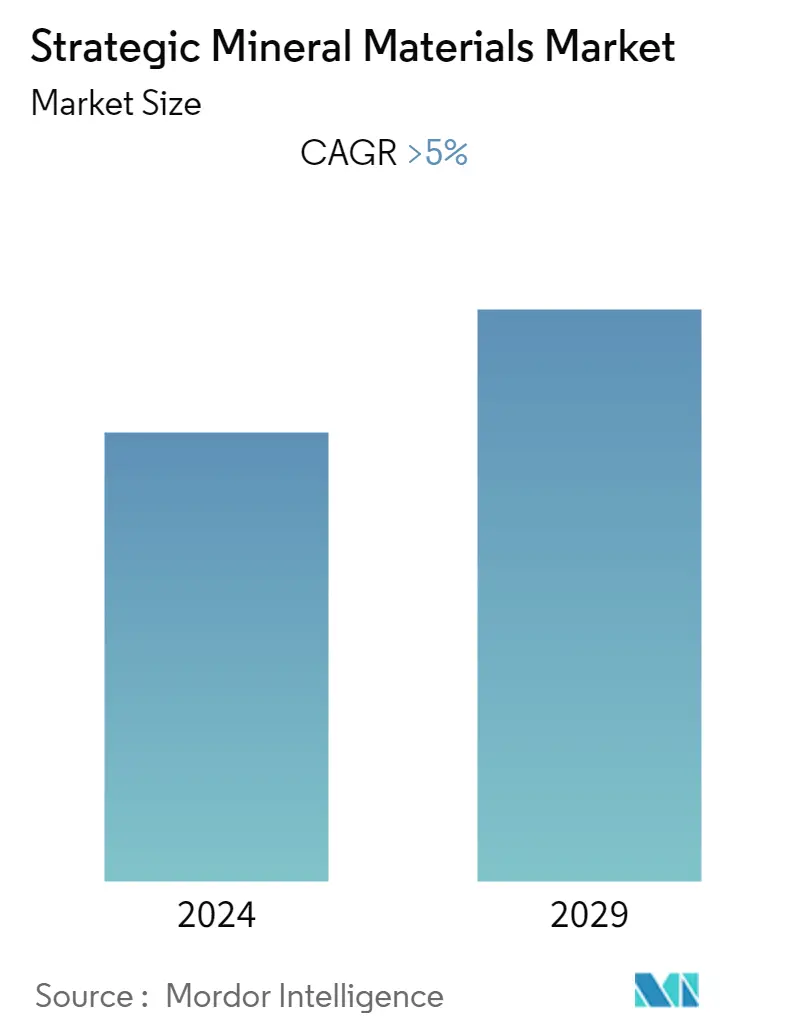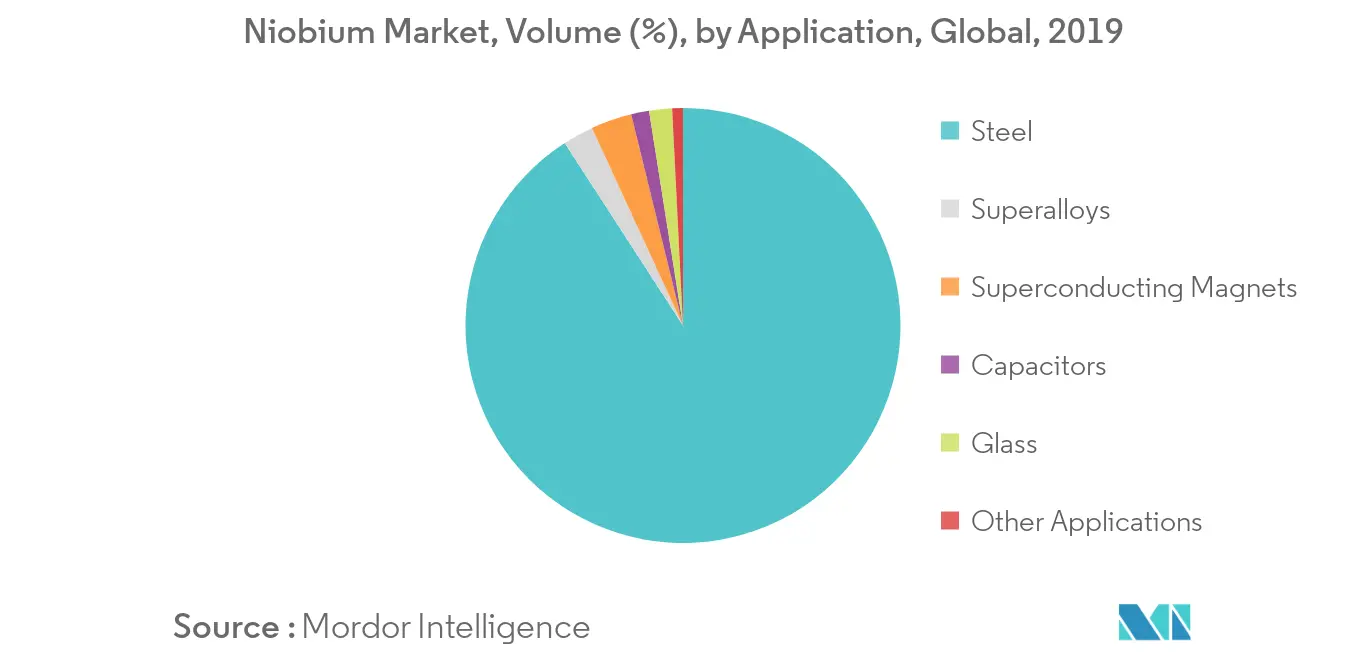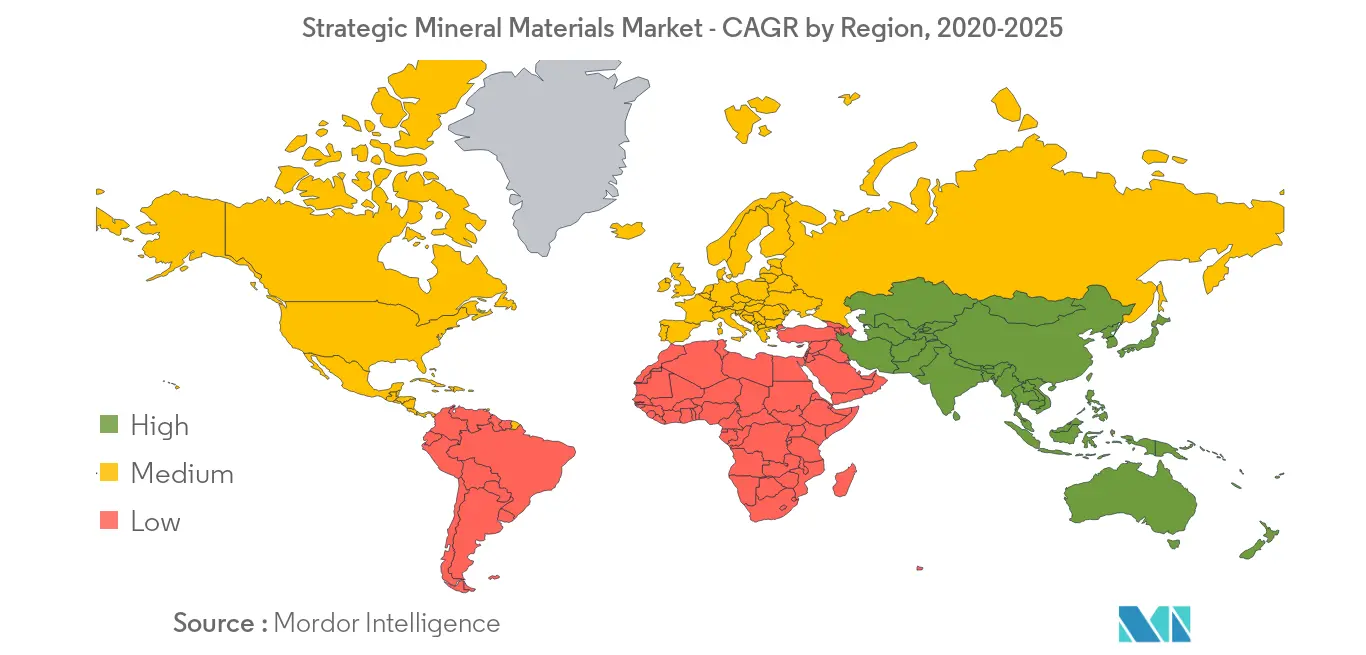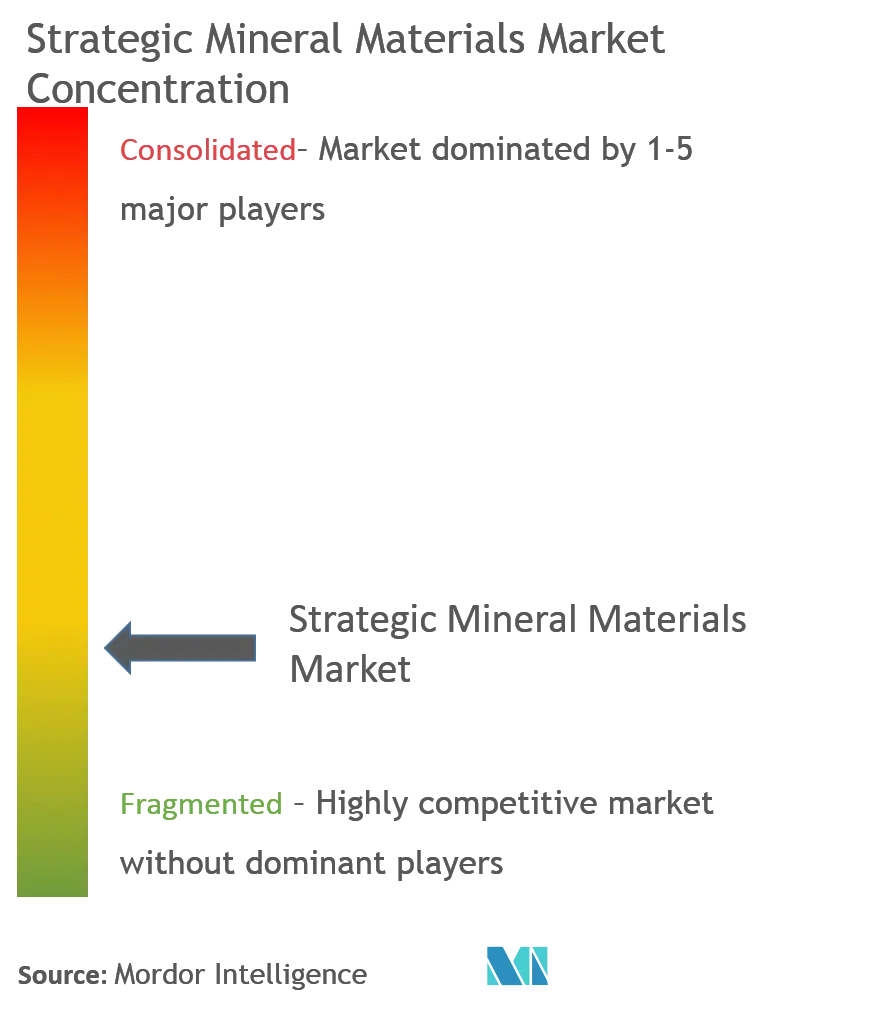Strategic Mineral Materials Market Size

| Study Period | 2019 - 2029 |
| Base Year For Estimation | 2023 |
| Forecast Data Period | 2024 - 2029 |
| CAGR | 5.00 % |
| Fastest Growing Market | Asia Pacific |
| Largest Market | Asia Pacific |
Major Players
*Disclaimer: Major Players sorted in no particular order |
Strategic Mineral Materials Market Analysis
The market for strategic mineral materials is expected to witness a CAGR of around 5% during the forecast period. Growing demand for different strategic minerals from various end-user industries such as eletrical and electronics, automotive, aerospace, and construction, among others is likely to drive the market growth.
- On the flipside, the impact of COVID-19 pandemic and increasing environmental concerns regarding mining operations is expected to hinder the growth of the market.
- Increasing application base for various strategic minerals is projected to act as an opportunity in the future.
- Asia-Pacific dominated the market with the largest consumption coming from China, followed by India, South Korea, and Japan.
Strategic Mineral Materials Market Trends
This section covers the major market trends shaping the Strategic Mineral Materials Market according to our research experts:
Steel Application to Dominate the Niobium Segment
- In general, the properties of steel depend on its chemical composition concerning carbon, manganese, phosphorus, silicon, alloying and micro-alloying elements, and processing conditions. Generally, the easiest way to increase the strength of steel is improving its carbon content. But this adversely affects other necessary properties, such as weldability, toughness, and formability.
- However, niobium has a high affinity for carbon, forming carbides and carbon nitrides, therefore, it is often added to steel and stainless steel in the form of ferro-niobium to maintain a balanced package of properties, the carbon and niobium levels being carefully matched with processing conditions to achieve the desired properties. The result, known as a micro-alloyed steel product, typically contains around 0.1% niobium by weight, often in conjunction with titanium and vanadium.
- In HSLA steel niobium is often less than 0.1% of the total alloy, but its role as a grain refiner makes a significant difference by increasing strength, weldability, ductility, and toughness of the steel. Strength is generated by grain refinement for the lower grades and a combination of grain refinement and precipitation hardening for the higher grades.
- Strength is generated by grain refinement for the lower grades and a combination of grain refinement and precipitation hardening for the higher grades. These steels are described as interstitial-free, since niobium and titanium fix interstitial elements, like carbon and nitrogen.
- However, the best results are usually achieved with a combination of micro alloys that exploit synergistic benefits. An example of this is the use of niobium and titanium together in 'exposed' interstitial-free steel automobile parts where superior surface quality is essential.
- Most modern HSLA steels fall into this 'low carbon' category. Globally, 90% of the niobium products are used in the steel industry.
- The largest use for niobium in high-strength and low-alloy (HSLA) steel is for automobiles, oil pipelines, and construction. HSLA steels are also used in nuclear reactors (alloyed with zirconium to make core elements), wind turbines, railroad tracks, and in ship building. HSLA steels consume approximately 90% of the annual niobium production.
- Ferro niobium is the most widely used product in the steel industry, which is mainly applied in four fields of the pipeline, automobile, structure, and stainless steel. As for the pipeline industry, the application in China is in line with that in the other parts of the world, but the difference is significant in the application in automotive steel, structural steel, and stainless steel industries.

Asia-Pacific to Dominate the Market
Asia-Pacific dominated the global market. With accelerating usage of various minerals in different applications in countries, such as China, India, South Korea, and Japan, the market studied is likley to witness significant growth during the forecast period. The Asia-Pacific electrical and electronics industry (including semiconductors and telecommunications) grew rapidly in the recent past, owing to the high demand from countries, like India and China. There is a high demand for modern electronic products, due to the rapid pace of innovation, the advancement of technology, and R&D activities in the electronics industry. There is a growth in the number of manufacturing plants and development centers, focusing on high-end products. Aerospace is the another major end-user industry for strategic mineral materials. The demand for aircraft is increasing across the world, and the aerospace industry is aiming to introduce innovative solutions to improve the manufacturing time and save costs. Therefore, the aforementioned factors are accelerating the usage of strategic mineral materials from various applications during the forecast period. However, the demand is likely to be affected during 2020 as well, as economic performance and demand are likely to remain affected by the current COVID-19 pandemic in the region.

Strategic Mineral Materials Industry Overview
The global strategic mineral materials market is fragmented in nature with the presence of numerous players for different minerals. The prominent companies in the market includes Intercontinental Mining, Vale, Anglo American plc, Glencore, CBMM, and Materion Corporation, among others.
Strategic Mineral Materials Market Leaders
-
Anglo American plc
-
Glencore
-
Intercontinental Mining
-
Materion Corporation
-
Vale
*Disclaimer: Major Players sorted in no particular order

Strategic Mineral Materials Market Report - Table of Contents
1. INTRODUCTION
- 1.1 Study Assumptions
- 1.2 Scope of the Study
2. RESEARCH METHODOLOGY
3. EXECUTIVE SUMMARY
4. MARKET DYNAMICS
-
4.1 Drivers
- 4.1.1 Growing Demand from Various End-user Industries
- 4.1.2 Other Drivers
-
4.2 Restraints
- 4.2.1 Impact of COVID-19 Pandemic
- 4.2.2 Growing Environmental Concerns over Mining Operations
- 4.3 Industry Value-chain Analysis
-
4.4 Porter's Five Forces Analysis
- 4.4.1 Bargaining Power of Suppliers
- 4.4.2 Bargaining Power of Consumers
- 4.4.3 Threat of New Entrants
- 4.4.4 Threat of Substitute Products and Services
- 4.4.5 Degree of Competition
5. MARKET SEGMENTATION
-
5.1 Mineral
- 5.1.1 Antimony
- 5.1.1.1 Flame Retardants
- 5.1.1.2 Batteries
- 5.1.1.3 Ceramics and Glass
- 5.1.1.4 Catalyst
- 5.1.1.5 Alloys
- 5.1.2 Barite
- 5.1.2.1 Oil and Gas
- 5.1.2.2 Other Applications (paints, chemical manufacturing and others)
- 5.1.3 Beryllium
- 5.1.3.1 Electronics
- 5.1.3.2 Aerospace
- 5.1.3.3 Automotive
- 5.1.3.4 Energy
- 5.1.3.5 Other Applications
- 5.1.4 Cobalt
- 5.1.4.1 Batteries
- 5.1.4.2 Superalloys
- 5.1.4.3 Cemented Carbides and Diamond Tools
- 5.1.4.4 Catalysts
- 5.1.4.5 Other Applications
- 5.1.5 Fluorspar
- 5.1.5.1 Chemicals
- 5.1.5.2 Steel
- 5.1.5.3 Aluminum
- 5.1.5.4 Cement
- 5.1.5.5 Other Applications
- 5.1.6 Gallium
- 5.1.6.1 Integrated Circuits
- 5.1.6.2 Laser diodes
- 5.1.6.3 Photodetectors
- 5.1.6.4 Solar Cells
- 5.1.6.5 Other Applications
- 5.1.7 Germanium
- 5.1.7.1 Fiber Optics
- 5.1.7.2 Infrared Optics
- 5.1.7.3 Catalyst
- 5.1.7.4 Electrical and Solar Equipment
- 5.1.7.5 Other Applications
- 5.1.8 Indium
- 5.1.8.1 Flat-Panel Display Screens and Touchscreens
- 5.1.8.2 Low Melting Alloys and Solders
- 5.1.8.3 Semiconductors
- 5.1.8.4 Transparent Heat Reflectors
- 5.1.8.5 Other Applications
- 5.1.9 Manganese
- 5.1.9.1 Casting Alloys
- 5.1.9.2 Packaging
- 5.1.9.3 Transportation
- 5.1.9.4 Construction
- 5.1.9.5 Other Applications
- 5.1.10 Niobium
- 5.1.10.1 Steel
- 5.1.10.2 Super Alloys
- 5.1.10.3 Superconducting Magnets
- 5.1.10.4 Capacitors
- 5.1.10.5 Glass
- 5.1.10.6 Other Applications
- 5.1.11 Platinum Group Elements
- 5.1.11.1 Autocatalyst
- 5.1.11.2 Jewelry
- 5.1.11.3 Electrical & Electronics
- 5.1.11.4 Chemical
- 5.1.11.5 Other Applications
- 5.1.12 Rare Earth Elements
- 5.1.12.1 Catalyst
- 5.1.12.2 Batteries
- 5.1.12.3 Magnetic Alloys
- 5.1.12.4 Metallurgy
- 5.1.12.5 Other Applications
- 5.1.13 Tantalum
- 5.1.13.1 Electronics
- 5.1.13.2 Medical
- 5.1.13.3 Aerospace
- 5.1.13.4 Automotive
- 5.1.13.5 Other Applications
-
5.2 Geography
- 5.2.1 Asia-Pacific
- 5.2.1.1 China
- 5.2.1.2 India
- 5.2.1.3 Japan
- 5.2.1.4 South Korea
- 5.2.1.5 ASEAN Countries
- 5.2.1.6 Rest of Asia-Pacific
- 5.2.2 North America
- 5.2.2.1 United States
- 5.2.2.2 Canada
- 5.2.2.3 Mexico
- 5.2.3 Europe
- 5.2.3.1 Germany
- 5.2.3.2 United Kingdom
- 5.2.3.3 Italy
- 5.2.3.4 France
- 5.2.3.5 Spain
- 5.2.3.6 Rest of Europe
- 5.2.4 South America
- 5.2.4.1 Brazil
- 5.2.4.2 Argentina
- 5.2.4.3 Rest of South America
- 5.2.5 Middle-East and Africa
- 5.2.5.1 Saudi Arabia
- 5.2.5.2 South Africa
- 5.2.5.3 Rest of Middle-East and Africa
6. COMPETITIVE LANDSCAPE
- 6.1 Mergers & Acquisitions, Joint Ventures, Collaborations and Agreements
- 6.2 Market Share/Ranking Analysis**
- 6.3 Strategies Adopted by Leading Players
-
6.4 Company Profiles
- 6.4.1 Anglo American plc
- 6.4.2 CBMM
- 6.4.3 Glencore
- 6.4.4 Indium Corporation
- 6.4.5 Intercontinental Mining
- 6.4.6 Materion Corporation
- 6.4.7 South32
- 6.4.8 Vale
- 6.4.9 WARRIOR GOLD INC.
- *List Not Exhaustive
7. MARKET OPPORTUNITIES AND FUTURE TRENDS
- 7.1 Increasing Application base of Various Minerals
Strategic Mineral Materials Industry Segmentation
The strategic mineral materials market report includes:
| Mineral | Antimony | Flame Retardants |
| Batteries | ||
| Ceramics and Glass | ||
| Catalyst | ||
| Alloys | ||
| Mineral | Barite | Oil and Gas |
| Other Applications (paints, chemical manufacturing and others) | ||
| Mineral | Beryllium | Electronics |
| Aerospace | ||
| Automotive | ||
| Energy | ||
| Other Applications | ||
| Mineral | Cobalt | Batteries |
| Superalloys | ||
| Cemented Carbides and Diamond Tools | ||
| Catalysts | ||
| Other Applications | ||
| Mineral | Fluorspar | Chemicals |
| Steel | ||
| Aluminum | ||
| Cement | ||
| Other Applications | ||
| Mineral | Gallium | Integrated Circuits |
| Laser diodes | ||
| Photodetectors | ||
| Solar Cells | ||
| Other Applications | ||
| Mineral | Germanium | Fiber Optics |
| Infrared Optics | ||
| Catalyst | ||
| Electrical and Solar Equipment | ||
| Other Applications | ||
| Mineral | Indium | Flat-Panel Display Screens and Touchscreens |
| Low Melting Alloys and Solders | ||
| Semiconductors | ||
| Transparent Heat Reflectors | ||
| Other Applications | ||
| Mineral | Manganese | Casting Alloys |
| Packaging | ||
| Transportation | ||
| Construction | ||
| Other Applications | ||
| Mineral | Niobium | Steel |
| Super Alloys | ||
| Superconducting Magnets | ||
| Capacitors | ||
| Glass | ||
| Other Applications | ||
| Mineral | Platinum Group Elements | Autocatalyst |
| Jewelry | ||
| Electrical & Electronics | ||
| Chemical | ||
| Other Applications | ||
| Mineral | Rare Earth Elements | Catalyst |
| Batteries | ||
| Magnetic Alloys | ||
| Metallurgy | ||
| Other Applications | ||
| Mineral | Tantalum | Electronics |
| Medical | ||
| Aerospace | ||
| Automotive | ||
| Other Applications | ||
| Geography | Asia-Pacific | China |
| India | ||
| Japan | ||
| South Korea | ||
| ASEAN Countries | ||
| Rest of Asia-Pacific | ||
| Geography | North America | United States |
| Canada | ||
| Mexico | ||
| Geography | Europe | Germany |
| United Kingdom | ||
| Italy | ||
| France | ||
| Spain | ||
| Rest of Europe | ||
| Geography | South America | Brazil |
| Argentina | ||
| Rest of South America | ||
| Geography | Middle-East and Africa | Saudi Arabia |
| South Africa | ||
| Rest of Middle-East and Africa |
Strategic Mineral Materials Market Research FAQs
What is the current Strategic Mineral Materials Market size?
The Strategic Mineral Materials Market is projected to register a CAGR of greater than 5% during the forecast period (2024-2029)
Who are the key players in Strategic Mineral Materials Market?
Anglo American plc, Glencore, Intercontinental Mining, Materion Corporation and Vale are the major companies operating in the Strategic Mineral Materials Market.
Which is the fastest growing region in Strategic Mineral Materials Market?
Asia Pacific is estimated to grow at the highest CAGR over the forecast period (2024-2029).
Which region has the biggest share in Strategic Mineral Materials Market?
In 2024, the Asia Pacific accounts for the largest market share in Strategic Mineral Materials Market.
What years does this Strategic Mineral Materials Market cover?
The report covers the Strategic Mineral Materials Market historical market size for years: 2019, 2020, 2021, 2022 and 2023. The report also forecasts the Strategic Mineral Materials Market size for years: 2024, 2025, 2026, 2027, 2028 and 2029.
Strategic Mineral Materials Industry Report
Statistics for the 2024 Strategic Mineral Materials market share, size and revenue growth rate, created by Mordor Intelligence™ Industry Reports. Strategic Mineral Materials analysis includes a market forecast outlook 2029 and historical overview. Get a sample of this industry analysis as a free report PDF download.



